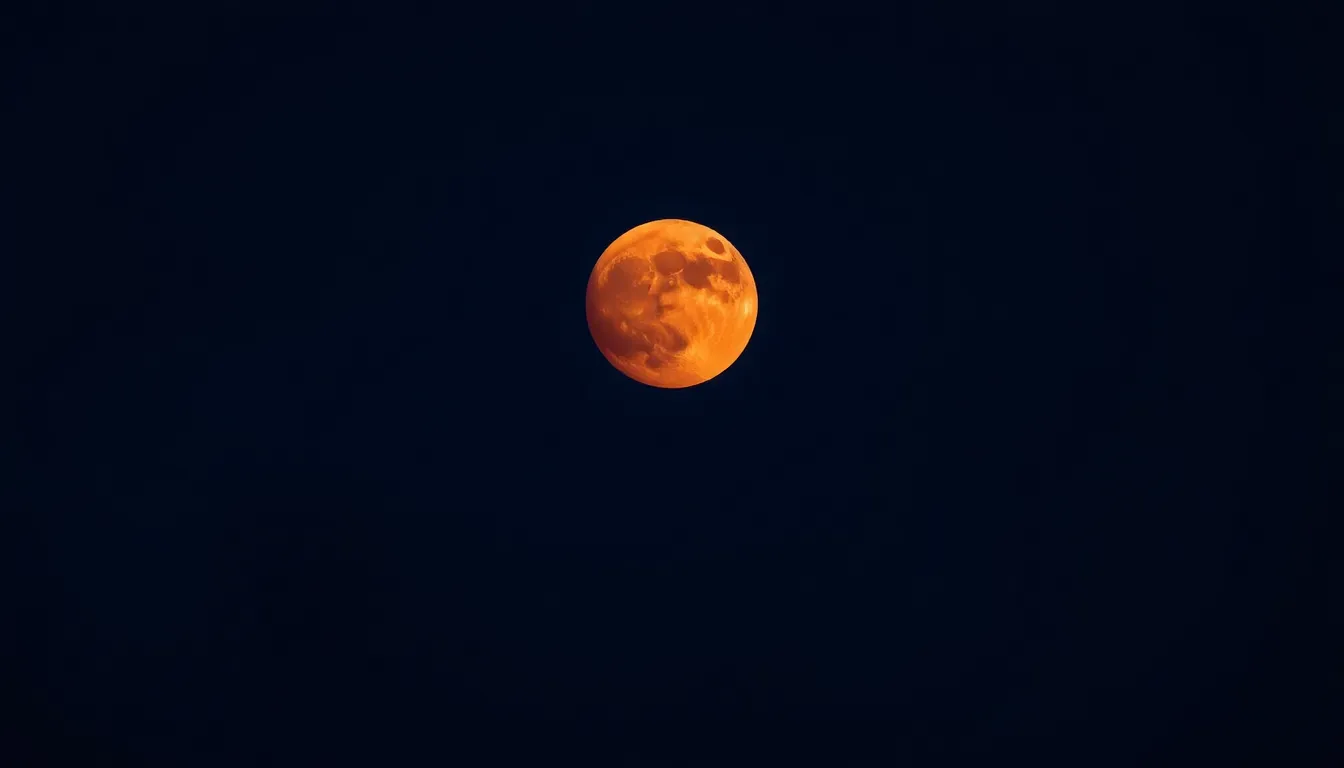Eclipses are nature’s way of throwing a cosmic party, and everyone’s invited! Whether it’s the moon photobombing the sun during a solar eclipse or the Earth casting its shadow on the moon in a lunar eclipse, these celestial events never fail to captivate. They’re like the universe’s version of a magic show—one moment the sun is shining bright, and the next, it’s playing hide and seek.
Table of Contents
ToggleOverview of Lunar Eclipse and Solar Eclipse
Eclipses represent fascinating celestial phenomena. A lunar eclipse occurs when Earth positions itself between the sun and the moon. This positioning allows Earth’s shadow to darken the moon’s surface, creating stunning views. These eclipses happen during a full moon, but only when the Earth, sun, and moon align perfectly.
In contrast, a solar eclipse happens when the moon shifts between the sun and Earth. This occurrence blocks sunlight, casting a shadow on Earth. Solar eclipses can only take place during a new moon. Different types of solar eclipses exist, classified mainly as total, partial, and annular eclipses. A total solar eclipse obscures the sun completely, while a partial solar eclipse covers part of the sun. An annular solar eclipse results in a ring-like appearance of the sun around the moon.
Timing plays a key role in both types of eclipses. Lunar eclipses can last for several hours, providing ample opportunity for observation. Typically, solar eclipses last only a few minutes, which intensifies their rarity and allure. Although lunar eclipses are visible from anywhere on the night side of Earth, solar eclipses are only observable from specific locations along the eclipse’s path.
Each type of eclipse captures imaginations, inspiring awe and curiosity. Public interest and scientific study contribute to understanding these cosmic events. Eclipses remind observers of the intricate dance of celestial bodies.
Types of Lunar Eclipses

Lunar eclipses occur in three primary forms: total, partial, and penumbral, each showcasing a unique interaction between the Earth, moon, and sun.
Total Lunar Eclipse
A total lunar eclipse happens when Earth’s shadow completely covers the moon. This event can create a stunning reddish hue on the moon’s surface, commonly referred to as a “blood moon.” Observers worldwide witness this phenomenon only during a full moon. Lasting several hours, it allows ample time for viewing and appreciation. Total lunar eclipses occur roughly every 2.5 years, depending on the alignment of these celestial bodies.
Partial Lunar Eclipse
During a partial lunar eclipse, only a portion of the moon enters Earth’s shadow. This results in a part of the moon darkening while the remaining part stays illuminated. The effect creates an intriguing contrast across the moon’s surface. These eclipses can appear anywhere Earth’s night side faces the moon, making them more accessible than total eclipses. Partial lunar eclipses occur more frequently, with several events happening within a single year.
Penumbral Lunar Eclipse
A penumbral lunar eclipse takes place when the moon passes through the Earth’s penumbral shadow. This shadow causes a subtle shading on the moon’s face, often difficult to distinguish. Observers may find it challenging to notice any significant change during the event. The phenomenon lasts longer than other lunar eclipses, typically spanning a few hours. Although less dramatic, penumbral eclipses offer an opportunity to observe the moon’s movement through Earth’s shadow.
Types of Solar Eclipses
Solar eclipses divide into three main types: total, partial, and annular. Each type offers a distinct visual experience, showcasing the unique positioning of the sun, moon, and Earth.
Total Solar Eclipse
A total solar eclipse occurs when the moon completely blocks the sun’s disk. Observers within the path of totality experience complete darkness during the day, while the sun’s corona becomes visible. This phenomenon lasts only a few minutes but creates profound visual and emotional impacts. Total solar eclipses happen approximately every 18 months somewhere on Earth. They attract significant attention, drawing crowds of viewers and scientists eager to witness this extraordinary event.
Partial Solar Eclipse
A partial solar eclipse happens when the moon partially obscures the sun. Most onlookers in the broader region outside the path of totality can see this type of eclipse, with varying degrees of coverage. Depending on the alignment, observers witness a crescent-shaped sun as the moon cuts across its face. These eclipses are more frequent than total solar eclipses, occurring at least 2 to 5 times a year globally. Interest remains high, as even a short-lived partial eclipse can captivate many.
Annular Solar Eclipse
An annular solar eclipse features the moon covering the sun’s center, resulting in a “ring of fire” visible around the edges. The apparent size of the moon does not entirely block the sun, creating a striking visual effect. Observers positioned along the annular path experience this unique spectacle, while others see a partial eclipse. Annular eclipses occur approximately once or twice a year, with excitement surrounding their rarity and beauty. Astronomy enthusiasts prioritize these events, traveling great distances to be within the optimal viewing area.
Cultural Significance of Eclipses
Eclipses hold a rich tapestry of cultural significance across various societies. These celestial events spark imagination and intrigue, fostering connections between humanity and the cosmos.
Myths and Legends
Many cultures create myths surrounding eclipses to explain their mysterious appearances. In ancient Greece, eclipses were seen as bad omens signaling turmoil or change. Similarly, in some Native American traditions, a lunar eclipse was viewed as a battle between the moon and dark forces. Ancient Egyptians regarded solar eclipses as a manifestation of Ra, their sun god, losing power temporarily. In contrast, Hindu beliefs celebrate solar eclipses with rituals, when followers gather to bathe in holy rivers. These legends and beliefs illustrate the profound impact of eclipses on human thought, shaping traditions and collective understanding.
Scientific Discoveries
Scientific exploration of eclipses has led to significant advancements in astronomy. Key discoveries stem from studying solar eclipses, including Einstein’s theory of general relativity in 1919, which validated how gravity affects light. During a solar eclipse, scientists observe the sun’s corona, gaining insights into its composition and structure. Lunar eclipses similarly offer opportunities to study Earth’s shadow and its atmospheric effects on light. Each eclipse serves as a natural laboratory for researchers, enhancing knowledge about celestial mechanics and the universe. Observations during these events contribute extensively to our understanding of planet dynamics and the solar system.
Observing Eclipses Safely
Observing eclipses requires caution to protect eyesight and enhance the experience. Proper techniques ensure enjoyment while minimizing risk.
Viewing Lunar Eclipses
Lunar eclipses present fewer dangers compared to solar eclipses. The moon’s shadow doesn’t emit harmful light, making it safe to view with the naked eye. Telescopes and binoculars can enhance the visual experience but aren’t necessary. During a total lunar eclipse, the moon exhibits a dramatic red hue, captivating those who watch. Planning the viewing location away from city lights optimizes visibility and enhances the spectacle.
Viewing Solar Eclipses
Solar eclipses pose significant risks to eyesight if viewed without protection. Eclipse glasses certified to meet ISO 12312-2 standards shield eyes from harmful solar radiation. Other safe viewing methods include using solar filters or pinhole projectors. Total solar eclipses allow brief periods of safe naked-eye viewing when the sun is fully obscured. Observers should confirm their location aligns with the eclipse path to fully experience the event, as visibility varies across regions. Proper preparation ensures a memorable and safe viewing experience.
Eclipses are not just astronomical events; they’re reminders of the beauty and complexity of our universe. The captivating dance between the sun, moon, and Earth continues to inspire wonder and curiosity in people of all ages. Whether it’s the dramatic transformation during a solar eclipse or the serene shadowing of a lunar eclipse, each event offers a unique spectacle worth experiencing.
As viewers prepare to witness these celestial phenomena, understanding their nature and significance enriches the experience. With proper safety measures and planning, everyone can enjoy the magic of eclipses while marveling at the intricate relationships that govern our solar system.








